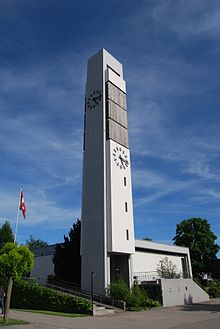Brother Klaus (Eschlikon)
The Brother Klaus Church is the Roman Catholic Church of Eschlikon in the canton of Thurgau . Eschlikon belongs to the parish Sirnach-Eschlikon .
Development and construction history
As early as the 1930s, the Eschlik Catholics wanted to have their own place of worship. For this reason, the Eschlikon-Wallenwil church building association was founded in 1936 . After the Second World War , the number of Catholics in Eschlikon increased, so that the building project for a church of its own received new impetus. In 1947 and 1959 the land for the church and the cemetery were purchased. In 1959, the preparatory work began, and in 1962 the parish assembly approved the construction of the Brother Klaus Church according to plans by the architect Otto Sperisen, who at the same time in Urdorf, Zurich, was also responsible for St. Bruder Klaus church dedicated to Brother Klaus built. On May 19, 1963 the foundation stone was laid by provost Gustav Lisibach. On June 14, 1964, the Bishop of Basel , Franziskus von Streng , inaugurated the Brother Klaus Church. In 1970 a hall was set up under the church, but it was replaced when the basement was redesigned in 2001–2002. The exterior was renovated in 2006 and the interior of the church was renovated in 2007.
Building description
Church tower and exterior
The church Bruder Klaus is located in the center on the corner of meadows and Hilagstrasse . The free-standing church tower has simply designed tower sides made of exposed concrete. A tower clock is attached on three sides , two sides have the sound openings of the bell chamber. These are clad with wooden slats, the number of which refers to the Trinity . The four bells were cast by Emil Eschmann in 1963 and sound in the tone sequence es, g, b, c. Outside and inside the church is designed in a moderately modern, sober, sober style. The visitor arrives at the church portal via an outside staircase . The Christ word can be read on the light wood of the doors : «I am the door. Whoever enters through me will be saved. " A stylized cross is depicted above the inscription. To the left of the portal is the foundation stone on which the Brother Klaus wheel is shown.
Interior and artistic equipment
The church has a rectangular ground plan, to the south-east at the side of the chancel was grown with rounded choir wall. The chancel is raised from the church interior by four steps. The visitor walks through the central aisle directly towards the altar and the tabernacle attached to the choir wall behind it . A crucifix with a corpus is attached above the tabernacle .
The ceiling of the church is clad with dark, square wooden panels. The original furnishings of the church include the stained glass windows designed by the Freiburg artist Yoki Aebischer in 1964. The southern window shows the visions of St. Brother Klaus. Above is the face of God, in the middle area the rosary and the staff of the saint can be seen, in the lower area the dove and sword refer to the peace mission of St. Brother Klaus. The second window is attached to the portrait of Mary. This second glass window shows, from top to bottom, a scale and a saw, then a jug with a mug and bread, and a cross can be seen below.
In the sanctuary, the altar is in the middle. It shows the tree of life with a peacock on its front . On the front of the anvil , which was newly placed during the church renovation, there is a cross and a snake biting its tail, which refers to the eternity of the Christian promise. As a special feature, there is a lectern on the left side of the altar on which the Bible rests. On the front of the desk, the seven seals can be seen, an allusion to the Revelation of John .
Two bronze statues are among the more recent items of equipment. The first is placed at the entrance to the church and shows St. Anthony of Padua distributing bread to the poor. The second statue shows the patron saint of the church, St. Brother Klaus spreading his hands in prayer and looking up at the sky. The Brother Klaus statue is set up by the reliquary on the south side of the room.
organ
The church initially received an interim organ from Hans Späth , Rapperswil SG . This instrument was moved to Zuckenriet in 1975 . The church got its current organ in 1975. It was made by Eugen Hauser from Schmerikon . It is an instrument with 19 registers , which was placed on a slightly raised place in the back of the church. The rectangular and square shapes of the church interior are taken up by the organ prospect. The case made of oak groups the registers into a Rückpositiv , a main and a pedal mechanism . During a revision in 1995, some registers were revised. The disposition is:
|
|
|
||||||||||||||||||||||||||||||||||||||||||||||||
- Coupling as kicks
- Tail windchest
- mechanical action
literature
- Angelus Hux, Alexander Troehler: KlangRäume. Churches and organs in Thurgau. Frauenfeld 2007.
Web links
Individual evidence
- ^ Brother Klaus Eschlikon Church. In: Parish website. Retrieved September 20, 2016.
- ↑ Representation of the bells on YouTube . Retrieved September 20, 2016.
- ↑ Hux, Troehler: KlangRäume. Churches and organs in Thurgau. 2007, p. 162.
- ↑ Hux, Troehler: KlangRäume. Churches and organs in Thurgau. 2007, p. 163.
- ^ Organ profile Catholic Church Brother Klaus Eschlikon TG. In: Organ directory Switzerland and Liechtenstein. Retrieved September 20, 2016.
Coordinates: 47 ° 27 '45.5 " N , 8 ° 57' 55.51" O ; CH1903: seven hundred fifteen thousand one hundred fourteen / 257993






